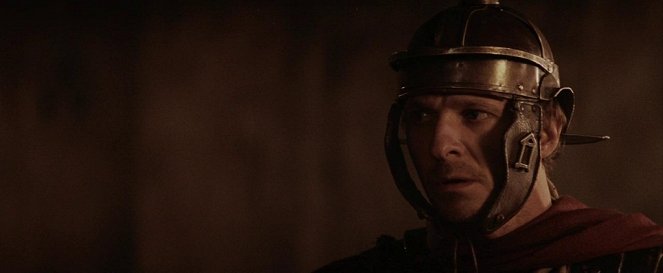Director:
Mel GibsonGuión:
Mel GibsonCámara:
Caleb DeschanelReparto:
James Caviezel, Maia Morgenstern, Hristo Jivkov, Francesco De Vito, Monica Bellucci, Mattia Sbragia, Toni Bertorelli, Luca Lionello, Hristo Shopov (más)Sinopsis(1)
Recrea las últimas doce horas en la vida de Jesús de Nazaret desde el momento en el que acude al Huerto de los Olivos (Getsemaní) a orar tras la Última Cena, enfrentándose a las tentaciones de Satanás. Allí sufre la traición de Judas Iscariote, siendo arrestado y conducido a Jerusalén para ser juzgado por blasfemia, según denuncian los fariseos. Jesús es presentado ante Pilatos, el Gobernador Romano en Palestina, quien escucha las acusaciones levantadas contra él y se da cuenta de que se trata de un conflicto político, delegando el asunto en el Rey Herodes que no tarda en devolverlo a las autoridades romanas para ser juzgado. De nuevo ante Pilatos, éste ofrece al pueblo la oportunidad de elegir a quien liberar: a Jesús o al asesino Barrabás. La multitud elige a Barrabás y condena a Jesús, que es puesto en manos de los soldados romanos y flagelado como castigo. Aunque Pilatos trata de hacer ver a la multitud que el castigo ya ha sido suficiente, los fariseos no lo consideran así. Lavándose las manos, ordena a sus hombres cumplir los deseos del pueblo y Jesús es condenado a muerte. (Aurum Producciones)
(más)Videos (1)
Reseñas (7)
La pasión de Cristo es una película intimista, casi teatral, con un impresionante concepto de pantalla grande. Su esencia no es el enorme escenario histórico, sino lo impresionante de las escenas perfectamente rodadas, que tienen lugar -tanto en interiores como en exteriores- en unas pocas decenas de metros cuadrados. La película comienza con una escena de caza de «algún joven desesperado», continúa con su linchamiento y termina con su muerte. Sólo sabemos quién se esconde bajo la capucha y quiénes son los otros rostros de la pantalla a través de breves flashbacks durante su tortura. La revelación de su identidad profundiza nuestra relación con Jesús de Nazaret y también nuestra experiencia del dolor por el que ellos mismos están pasando. El poder de la película reside en su descripción del indescriptible sufrimiento de un hombre con un gran corazón, causado por personas sin corazón. Mel Gibson elige el camino honesto de la narración sin una pizca de sentimentalismo. Se mantiene imparcial y literalmente se deleita linchando al hombre. A cámara lenta, en el dolor creciente del que sufre, nos hace sentir en igual proporción su dolor físico y las atrocidades de los instintos sádicos de sus verdugos. Esta chocante y fría entrada en el primer tercio nos tiene clavados a nuestros asientos, sólo para profundizar en todo lo macabro con flashbacks posteriores a los dichos espirituales de Jesús, dándole sentido, emoción y una dimensión filosófica. El mártir y sus verdugos se convierten en encarnaciones cada vez más poderosas de los valores del bien y del mal, y juntos crean una «obra» que cambiará la historia de la humanidad para siempre. ___ La película mantiene un ritmo lento y dura más de dos horas, pero no encontrarás en ella ni una sola toma, sonido o corte que no tenga su lugar y evoque la emoción que necesita. Es un poema hipnóticamente fluido y sombrío, que lleva a sus espaldas un enorme peso de urgencia, que se profundiza a cada minuto. O miras hacia otro lado, o aguantas la respiración, o piensas en lo que se ha dicho.
()
No hyperactivity turning to faith and as a result fortunately no exaggerated controversy. The crucifixion is brutal and cruel, but also impressive, touching, and surprisingly grand. Its fascinating atmosphere drew me in despite some prejudices, and I am glad that ten years after its creation, Gibson's opus is finally receiving positive reviews. This film is definitely not easy to love, but it is quite easy to be amazed by it.
()
I find this film hard to rate, even after a second viewing. If I were to rate only the major part of the film that precedes the journey to Golgotha, it would be 5 stars. Brilliantly played Pilate, Herod is an outright treat despite the small space and Mattia Sbragia is very convincing as the resolute Caiaphas. I really enjoyed the scenes of Pilate and Jesus together. The much criticized flashbacks are impressive and especially the one with Mary and Jesus at the table is really beautiful and full of emotions. But starting with The Road to Golgotha, Gibson's film loses its impact. Gibson made Christ a being who, by superhumanly overcoming all the immense hardships, seems implausible. I would argue that less is sometimes more, that a few slashes to the skin would be more painful and real than all those cuts covered in blood on something that used to resemble a human body. As a result, Christ’s suffering loses its human dimension. Also, the scene when a raven pecks out the eye of one of the crucified thieves has no support in the Gospels and smacks strongly of gratuitousness. Yet, I have to admit that the film has a certain amount of power, multiplied by the visit to the cinema, where everyone sat until the end credits finished rolling, which I haven't experienced for a long time. As an afterthought, I acknowledge that my original criticism about the total lack of ideas, and that it doesn't even come close to Scorsese's The Last Temptation of Christ is perhaps a bit off the mark. This film is not supposed to explain anything, to introduce characters in a clear way so that average viewers can understand. Perhaps the renowned Roger Ebert wrote it most succinctly: "This is not a sermon or a homily, but a visualization of the central event in the Christian religion. Take it or leave it.” But the question remains, is this film necessary? Gibson's artistic statement is ideally suited to a time when, thanks to the permanent threat of terrorism, the world is exposed to a clash of civilizations, a clash of religious principles, and the huge success of the film in the US can be attributed to the need for ideological refuge. And history repeats itself in cycles. The clashes among the Abrahamic religions – Judaism, Christianity and Islam – have and will continue to cause much blood and suffering. And it's not so much a problem of religion itself, but rather of the animal species called homo sapiens stupidus, which has a coded need for fight and cruelty, which is very clear in several scenes in Gibson's film. Let that be to his credit.
()
Those brutal scenes that everyone take dso much about weren't really that terrible. Rather than being naturalistic, they were just very bloody. In terms of craftsmanship, it is again precise, but that is not new for Mel Gibson. As for the content, there is nothing left but to describe it as controversial. The music is breathtaking.
()
A standard large-scale film production, baroque rigid faces of the actors, an attempt at distinctive artistic stylization, self-purpose escalated brutality, excellent soundtrack.... And all this is in the service of the sacred purpose of the film. Mel Gibson and Benedict Fitzgerald have chosen a very simple script trick, wherein they put reminiscences of the long-suffering and hardship of Jesus Christ in convenient places on familiar gospel scenes to reinforce the film's message. A message that I personally consider to be the most problematic part of a newly born phenomenon. This phenomenon speaks precisely to the part of the audience that is knowledgeable about biblical themes. It speaks in a way that is not dialogical, but purely illustrative. Here is the hero, this is what the evil Pharisees and the gloating people of Jerusalem did to him, and now you must feel indebted to him. Who Christ was, what is his message to the world — that is what The Passion of the Christ deals with very sketchily. It's not a testimony, but rather just a bloody portrayal of one of the greatest stories in human history. The biggest and most impressive. Mel Gibson actually gave the best testimony of the state of contemporary American cinema. The viewer is no more than sitting and staring while the "narrator" thinks for him. No one asks you to think, ask, or interpret during the film; even the strongest — that is, Christ's struggle with doubts about his mission — must be thematized into an embarrassingly literal character of the devil. Your only mission is to monitor the flow of carefully chewed and thoughtful "pseudo-reality", which has completely lost its symbolic validity and becomes a bloodthirsty direct transmission from the greatest execution of antiquity. And so, as the blood squirted into the orchestra, the makeup-smeared James Caviezel soiled the ground with artificial raspberry juice and made throaty sounds, I remembered a medieval liturgical drama where the same story is depicted with perspective and human kindness – loosely, playfully, with imagination, and it was a hundred times more impressive. Because while this is a celebration of human life, Gibson's "masterpiece" is merely a deafening invocation of deified death. Or: a "media event" once again triumphed over artistic quality... Not as bad or as good a film as some say.
()
Galería (102)
Foto © 2004 Icon Productions



Anuncio